Clinical Psychology: CBT Analysis and Formulation Report of Jo's Case
VerifiedAdded on 2021/04/24
|11
|3211
|43
Case Study
AI Summary
This case study examines a 21-year-old female client named Jo, who is experiencing several mental health issues. The assignment utilizes Cognitive Behavioral Therapy (CBT) to analyze Jo's problems, drawing on theoretical concepts to formulate a report. It explores the possible causes of her problems, including maladaptive schemas stemming from childhood experiences such as neglect, abuse, and parental separation. The report identifies factors maintaining Jo's issues, such as safety-seeking behaviors, avoidance, and short-term rewards, while also considering factors that could facilitate change. As a therapist, the assignment provides recommendations for CBT interventions, including behavioral activation, exposure techniques, and cognitive restructuring to improve her sleep, mood, problem-solving skills, and overall well-being, and also includes relapse prevention strategies. The goal is to help Jo address her negative cognitive triad and develop healthier coping mechanisms.
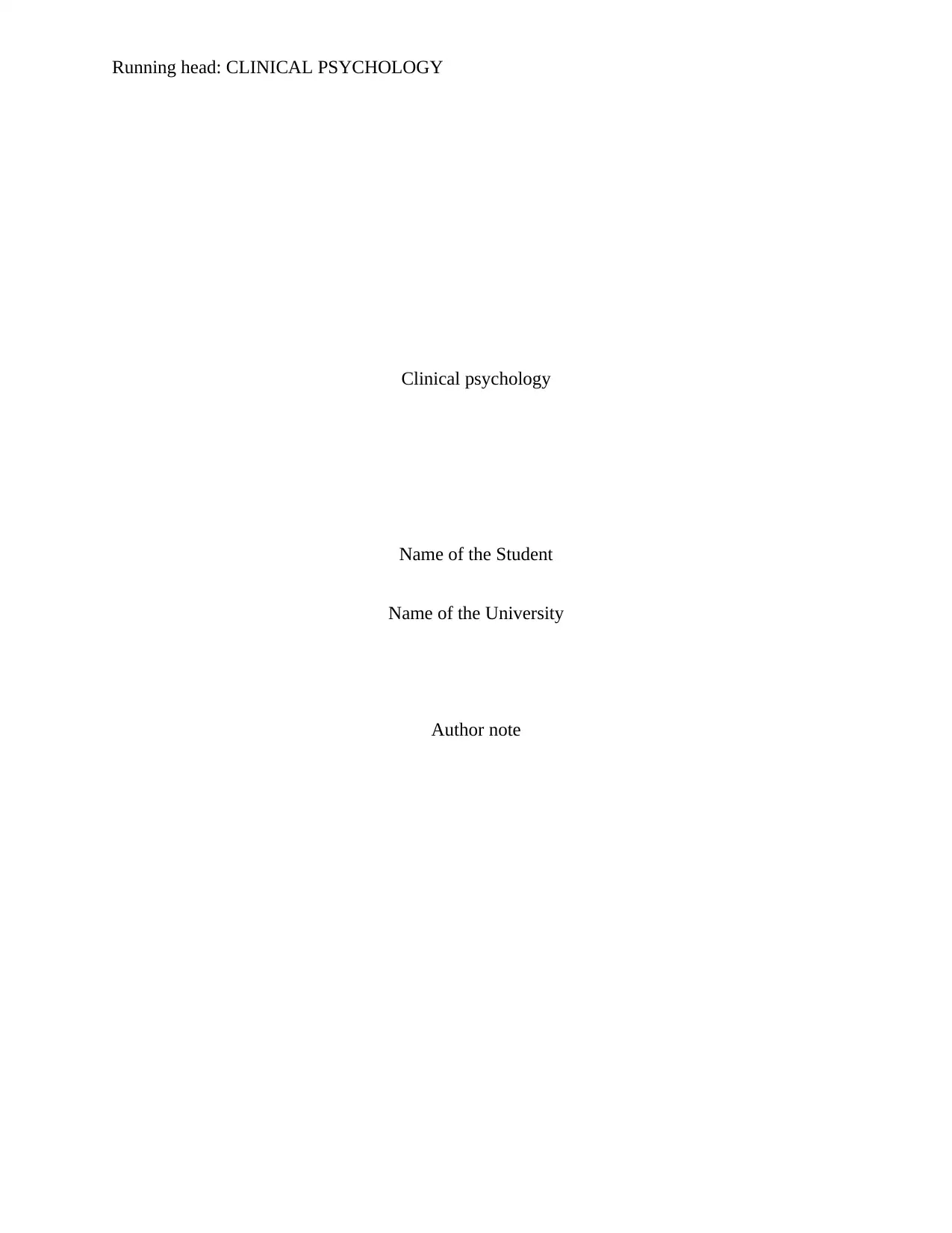
Running head: CLINICAL PSYCHOLOGY
Clinical psychology
Name of the Student
Name of the University
Author note
Clinical psychology
Name of the Student
Name of the University
Author note
Paraphrase This Document
Need a fresh take? Get an instant paraphrase of this document with our AI Paraphraser
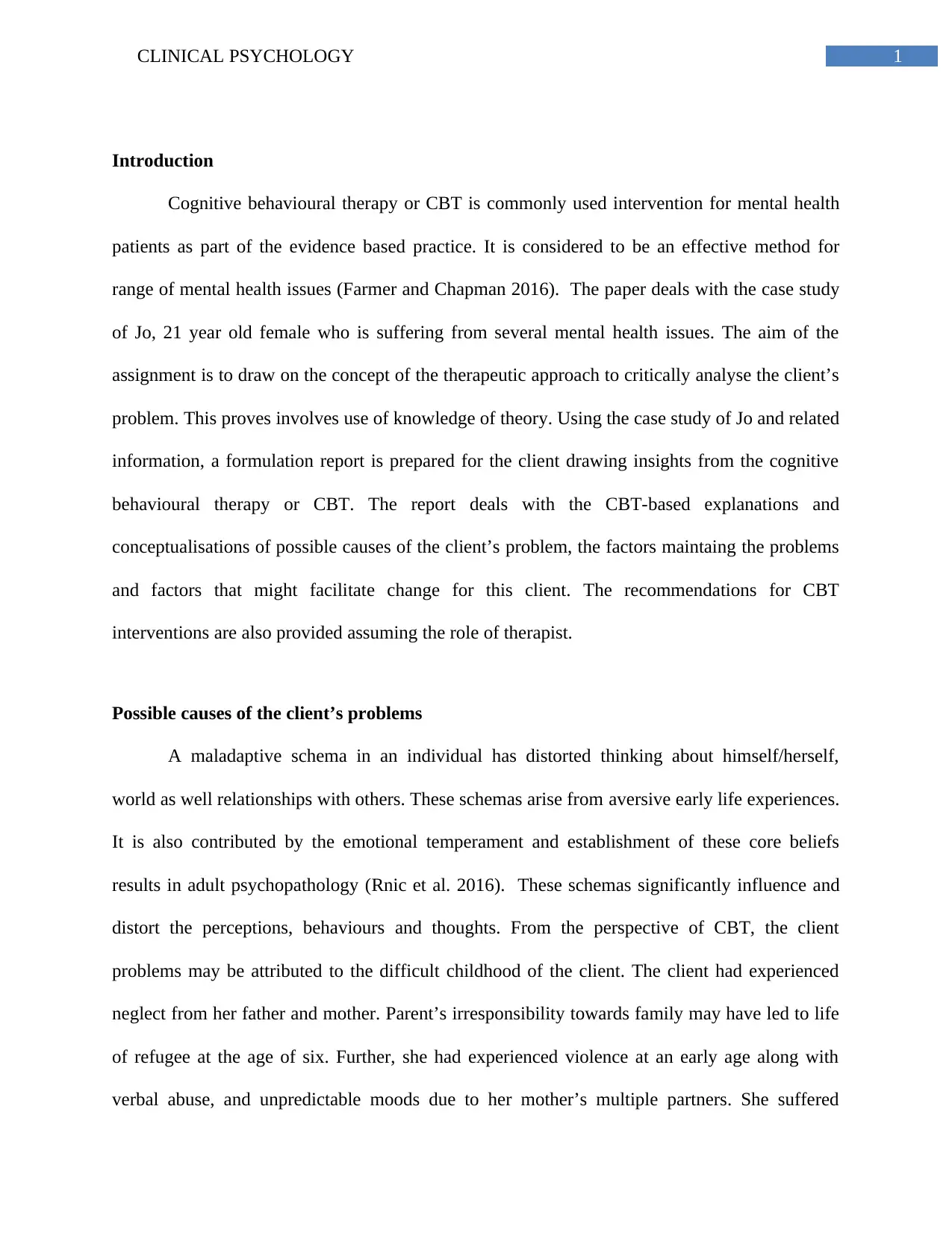
1CLINICAL PSYCHOLOGY
Introduction
Cognitive behavioural therapy or CBT is commonly used intervention for mental health
patients as part of the evidence based practice. It is considered to be an effective method for
range of mental health issues (Farmer and Chapman 2016). The paper deals with the case study
of Jo, 21 year old female who is suffering from several mental health issues. The aim of the
assignment is to draw on the concept of the therapeutic approach to critically analyse the client’s
problem. This proves involves use of knowledge of theory. Using the case study of Jo and related
information, a formulation report is prepared for the client drawing insights from the cognitive
behavioural therapy or CBT. The report deals with the CBT-based explanations and
conceptualisations of possible causes of the client’s problem, the factors maintaing the problems
and factors that might facilitate change for this client. The recommendations for CBT
interventions are also provided assuming the role of therapist.
Possible causes of the client’s problems
A maladaptive schema in an individual has distorted thinking about himself/herself,
world as well relationships with others. These schemas arise from aversive early life experiences.
It is also contributed by the emotional temperament and establishment of these core beliefs
results in adult psychopathology (Rnic et al. 2016). These schemas significantly influence and
distort the perceptions, behaviours and thoughts. From the perspective of CBT, the client
problems may be attributed to the difficult childhood of the client. The client had experienced
neglect from her father and mother. Parent’s irresponsibility towards family may have led to life
of refugee at the age of six. Further, she had experienced violence at an early age along with
verbal abuse, and unpredictable moods due to her mother’s multiple partners. She suffered
Introduction
Cognitive behavioural therapy or CBT is commonly used intervention for mental health
patients as part of the evidence based practice. It is considered to be an effective method for
range of mental health issues (Farmer and Chapman 2016). The paper deals with the case study
of Jo, 21 year old female who is suffering from several mental health issues. The aim of the
assignment is to draw on the concept of the therapeutic approach to critically analyse the client’s
problem. This proves involves use of knowledge of theory. Using the case study of Jo and related
information, a formulation report is prepared for the client drawing insights from the cognitive
behavioural therapy or CBT. The report deals with the CBT-based explanations and
conceptualisations of possible causes of the client’s problem, the factors maintaing the problems
and factors that might facilitate change for this client. The recommendations for CBT
interventions are also provided assuming the role of therapist.
Possible causes of the client’s problems
A maladaptive schema in an individual has distorted thinking about himself/herself,
world as well relationships with others. These schemas arise from aversive early life experiences.
It is also contributed by the emotional temperament and establishment of these core beliefs
results in adult psychopathology (Rnic et al. 2016). These schemas significantly influence and
distort the perceptions, behaviours and thoughts. From the perspective of CBT, the client
problems may be attributed to the difficult childhood of the client. The client had experienced
neglect from her father and mother. Parent’s irresponsibility towards family may have led to life
of refugee at the age of six. Further, she had experienced violence at an early age along with
verbal abuse, and unpredictable moods due to her mother’s multiple partners. She suffered
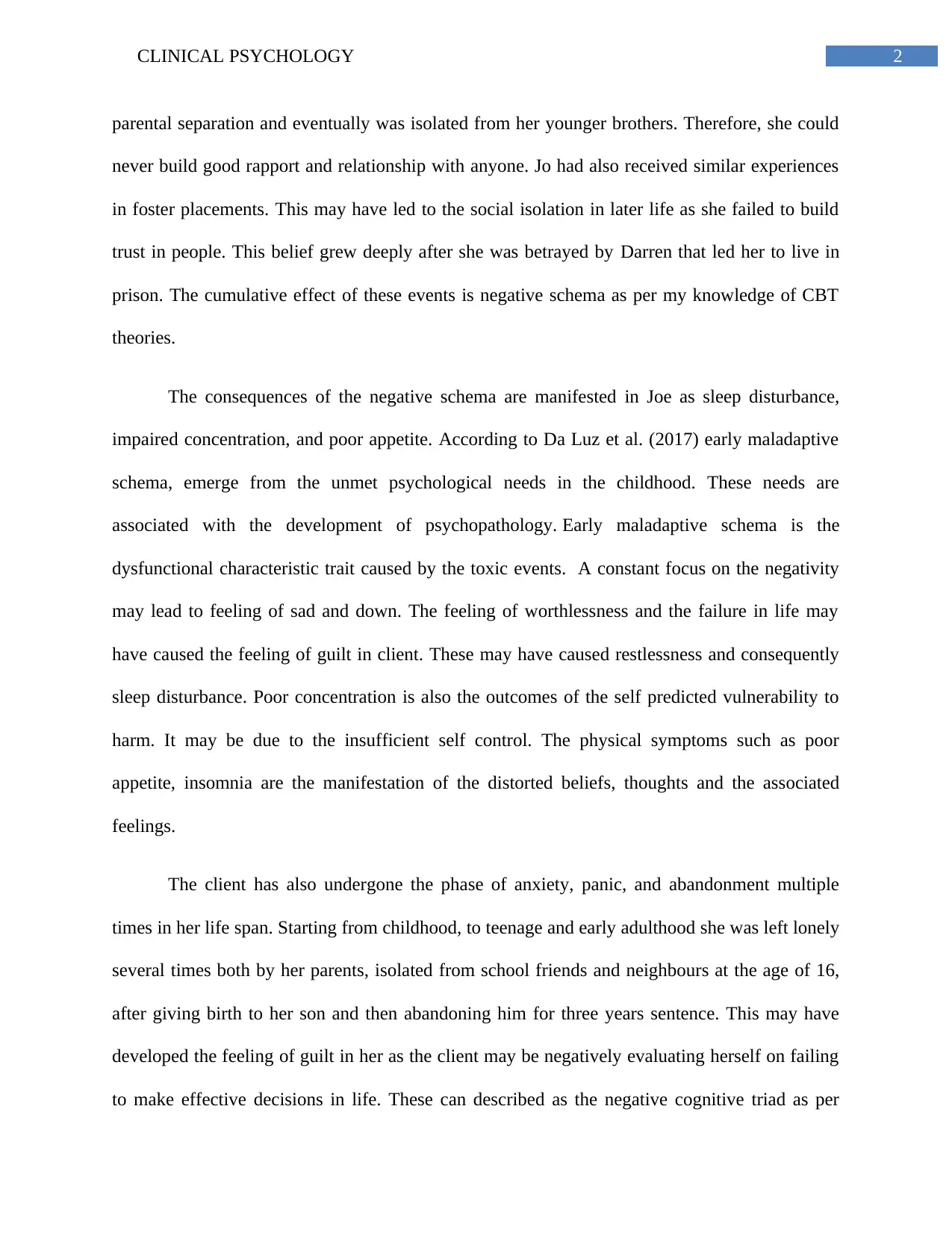
2CLINICAL PSYCHOLOGY
parental separation and eventually was isolated from her younger brothers. Therefore, she could
never build good rapport and relationship with anyone. Jo had also received similar experiences
in foster placements. This may have led to the social isolation in later life as she failed to build
trust in people. This belief grew deeply after she was betrayed by Darren that led her to live in
prison. The cumulative effect of these events is negative schema as per my knowledge of CBT
theories.
The consequences of the negative schema are manifested in Joe as sleep disturbance,
impaired concentration, and poor appetite. According to Da Luz et al. (2017) early maladaptive
schema, emerge from the unmet psychological needs in the childhood. These needs are
associated with the development of psychopathology. Early maladaptive schema is the
dysfunctional characteristic trait caused by the toxic events. A constant focus on the negativity
may lead to feeling of sad and down. The feeling of worthlessness and the failure in life may
have caused the feeling of guilt in client. These may have caused restlessness and consequently
sleep disturbance. Poor concentration is also the outcomes of the self predicted vulnerability to
harm. It may be due to the insufficient self control. The physical symptoms such as poor
appetite, insomnia are the manifestation of the distorted beliefs, thoughts and the associated
feelings.
The client has also undergone the phase of anxiety, panic, and abandonment multiple
times in her life span. Starting from childhood, to teenage and early adulthood she was left lonely
several times both by her parents, isolated from school friends and neighbours at the age of 16,
after giving birth to her son and then abandoning him for three years sentence. This may have
developed the feeling of guilt in her as the client may be negatively evaluating herself on failing
to make effective decisions in life. These can described as the negative cognitive triad as per
parental separation and eventually was isolated from her younger brothers. Therefore, she could
never build good rapport and relationship with anyone. Jo had also received similar experiences
in foster placements. This may have led to the social isolation in later life as she failed to build
trust in people. This belief grew deeply after she was betrayed by Darren that led her to live in
prison. The cumulative effect of these events is negative schema as per my knowledge of CBT
theories.
The consequences of the negative schema are manifested in Joe as sleep disturbance,
impaired concentration, and poor appetite. According to Da Luz et al. (2017) early maladaptive
schema, emerge from the unmet psychological needs in the childhood. These needs are
associated with the development of psychopathology. Early maladaptive schema is the
dysfunctional characteristic trait caused by the toxic events. A constant focus on the negativity
may lead to feeling of sad and down. The feeling of worthlessness and the failure in life may
have caused the feeling of guilt in client. These may have caused restlessness and consequently
sleep disturbance. Poor concentration is also the outcomes of the self predicted vulnerability to
harm. It may be due to the insufficient self control. The physical symptoms such as poor
appetite, insomnia are the manifestation of the distorted beliefs, thoughts and the associated
feelings.
The client has also undergone the phase of anxiety, panic, and abandonment multiple
times in her life span. Starting from childhood, to teenage and early adulthood she was left lonely
several times both by her parents, isolated from school friends and neighbours at the age of 16,
after giving birth to her son and then abandoning him for three years sentence. This may have
developed the feeling of guilt in her as the client may be negatively evaluating herself on failing
to make effective decisions in life. These can described as the negative cognitive triad as per
⊘ This is a preview!⊘
Do you want full access?
Subscribe today to unlock all pages.

Trusted by 1+ million students worldwide
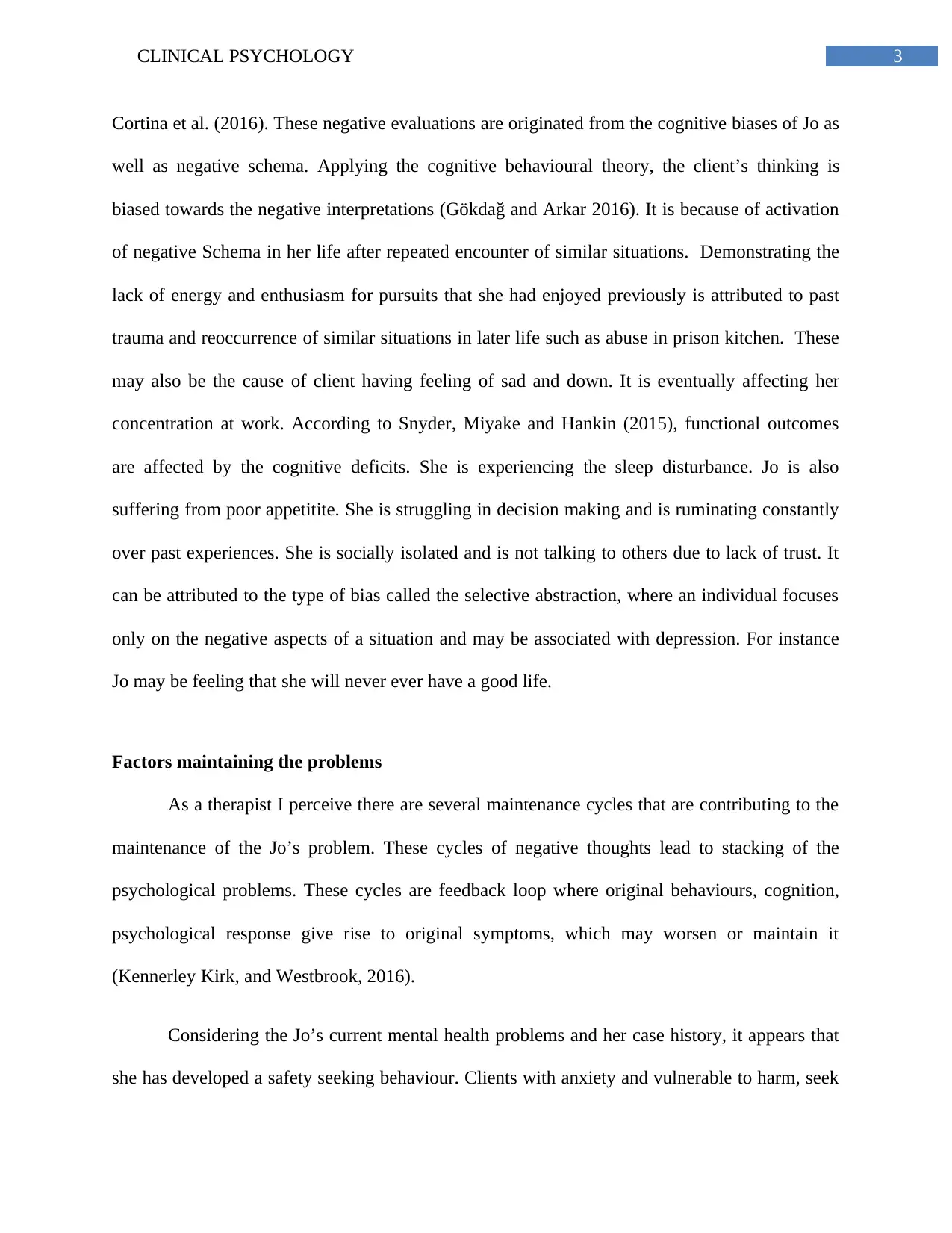
3CLINICAL PSYCHOLOGY
Cortina et al. (2016). These negative evaluations are originated from the cognitive biases of Jo as
well as negative schema. Applying the cognitive behavioural theory, the client’s thinking is
biased towards the negative interpretations (Gökdağ and Arkar 2016). It is because of activation
of negative Schema in her life after repeated encounter of similar situations. Demonstrating the
lack of energy and enthusiasm for pursuits that she had enjoyed previously is attributed to past
trauma and reoccurrence of similar situations in later life such as abuse in prison kitchen. These
may also be the cause of client having feeling of sad and down. It is eventually affecting her
concentration at work. According to Snyder, Miyake and Hankin (2015), functional outcomes
are affected by the cognitive deficits. She is experiencing the sleep disturbance. Jo is also
suffering from poor appetitite. She is struggling in decision making and is ruminating constantly
over past experiences. She is socially isolated and is not talking to others due to lack of trust. It
can be attributed to the type of bias called the selective abstraction, where an individual focuses
only on the negative aspects of a situation and may be associated with depression. For instance
Jo may be feeling that she will never ever have a good life.
Factors maintaining the problems
As a therapist I perceive there are several maintenance cycles that are contributing to the
maintenance of the Jo’s problem. These cycles of negative thoughts lead to stacking of the
psychological problems. These cycles are feedback loop where original behaviours, cognition,
psychological response give rise to original symptoms, which may worsen or maintain it
(Kennerley Kirk, and Westbrook, 2016).
Considering the Jo’s current mental health problems and her case history, it appears that
she has developed a safety seeking behaviour. Clients with anxiety and vulnerable to harm, seek
Cortina et al. (2016). These negative evaluations are originated from the cognitive biases of Jo as
well as negative schema. Applying the cognitive behavioural theory, the client’s thinking is
biased towards the negative interpretations (Gökdağ and Arkar 2016). It is because of activation
of negative Schema in her life after repeated encounter of similar situations. Demonstrating the
lack of energy and enthusiasm for pursuits that she had enjoyed previously is attributed to past
trauma and reoccurrence of similar situations in later life such as abuse in prison kitchen. These
may also be the cause of client having feeling of sad and down. It is eventually affecting her
concentration at work. According to Snyder, Miyake and Hankin (2015), functional outcomes
are affected by the cognitive deficits. She is experiencing the sleep disturbance. Jo is also
suffering from poor appetitite. She is struggling in decision making and is ruminating constantly
over past experiences. She is socially isolated and is not talking to others due to lack of trust. It
can be attributed to the type of bias called the selective abstraction, where an individual focuses
only on the negative aspects of a situation and may be associated with depression. For instance
Jo may be feeling that she will never ever have a good life.
Factors maintaining the problems
As a therapist I perceive there are several maintenance cycles that are contributing to the
maintenance of the Jo’s problem. These cycles of negative thoughts lead to stacking of the
psychological problems. These cycles are feedback loop where original behaviours, cognition,
psychological response give rise to original symptoms, which may worsen or maintain it
(Kennerley Kirk, and Westbrook, 2016).
Considering the Jo’s current mental health problems and her case history, it appears that
she has developed a safety seeking behaviour. Clients with anxiety and vulnerable to harm, seek
Paraphrase This Document
Need a fresh take? Get an instant paraphrase of this document with our AI Paraphraser
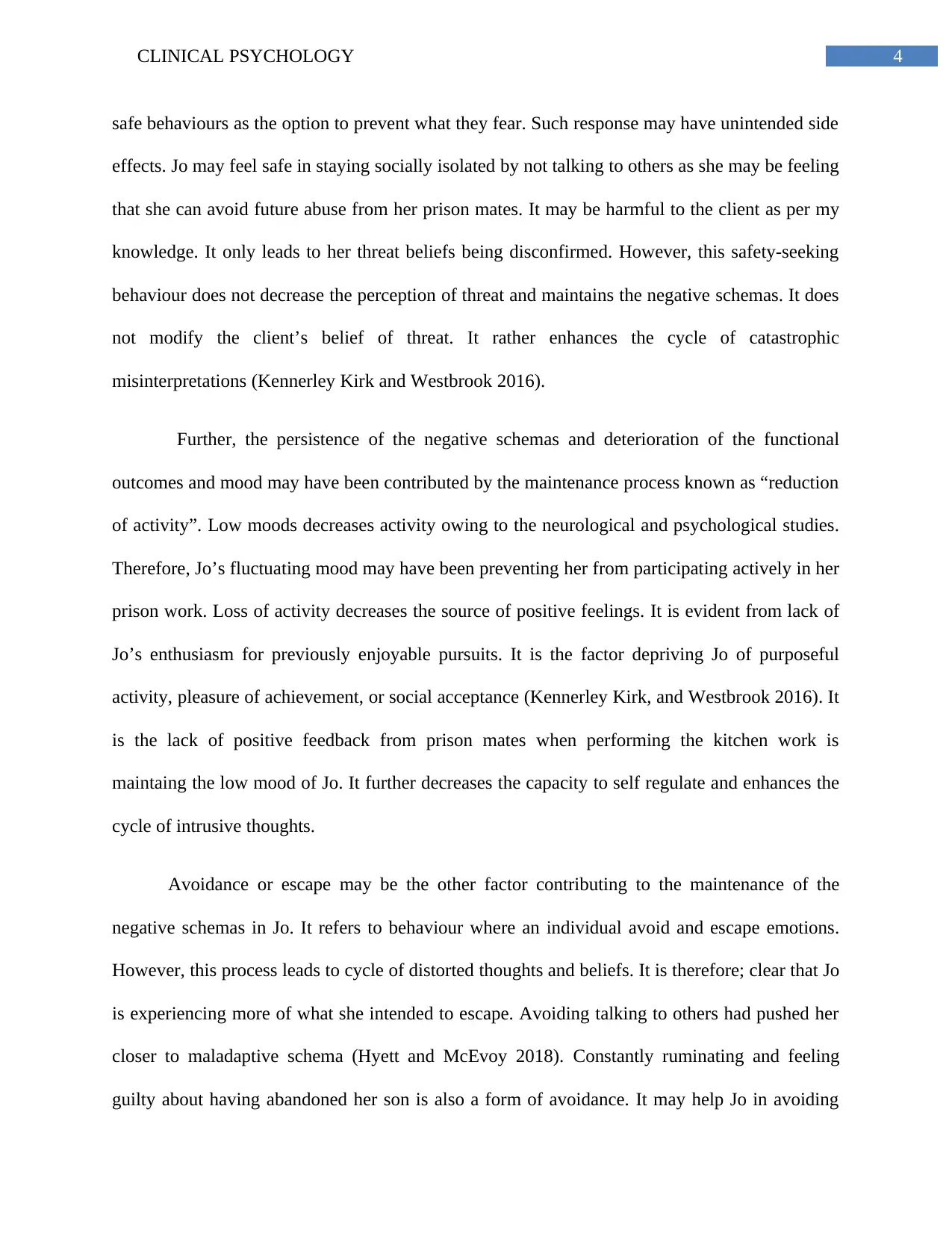
4CLINICAL PSYCHOLOGY
safe behaviours as the option to prevent what they fear. Such response may have unintended side
effects. Jo may feel safe in staying socially isolated by not talking to others as she may be feeling
that she can avoid future abuse from her prison mates. It may be harmful to the client as per my
knowledge. It only leads to her threat beliefs being disconfirmed. However, this safety-seeking
behaviour does not decrease the perception of threat and maintains the negative schemas. It does
not modify the client’s belief of threat. It rather enhances the cycle of catastrophic
misinterpretations (Kennerley Kirk and Westbrook 2016).
Further, the persistence of the negative schemas and deterioration of the functional
outcomes and mood may have been contributed by the maintenance process known as “reduction
of activity”. Low moods decreases activity owing to the neurological and psychological studies.
Therefore, Jo’s fluctuating mood may have been preventing her from participating actively in her
prison work. Loss of activity decreases the source of positive feelings. It is evident from lack of
Jo’s enthusiasm for previously enjoyable pursuits. It is the factor depriving Jo of purposeful
activity, pleasure of achievement, or social acceptance (Kennerley Kirk, and Westbrook 2016). It
is the lack of positive feedback from prison mates when performing the kitchen work is
maintaing the low mood of Jo. It further decreases the capacity to self regulate and enhances the
cycle of intrusive thoughts.
Avoidance or escape may be the other factor contributing to the maintenance of the
negative schemas in Jo. It refers to behaviour where an individual avoid and escape emotions.
However, this process leads to cycle of distorted thoughts and beliefs. It is therefore; clear that Jo
is experiencing more of what she intended to escape. Avoiding talking to others had pushed her
closer to maladaptive schema (Hyett and McEvoy 2018). Constantly ruminating and feeling
guilty about having abandoned her son is also a form of avoidance. It may help Jo in avoiding
safe behaviours as the option to prevent what they fear. Such response may have unintended side
effects. Jo may feel safe in staying socially isolated by not talking to others as she may be feeling
that she can avoid future abuse from her prison mates. It may be harmful to the client as per my
knowledge. It only leads to her threat beliefs being disconfirmed. However, this safety-seeking
behaviour does not decrease the perception of threat and maintains the negative schemas. It does
not modify the client’s belief of threat. It rather enhances the cycle of catastrophic
misinterpretations (Kennerley Kirk and Westbrook 2016).
Further, the persistence of the negative schemas and deterioration of the functional
outcomes and mood may have been contributed by the maintenance process known as “reduction
of activity”. Low moods decreases activity owing to the neurological and psychological studies.
Therefore, Jo’s fluctuating mood may have been preventing her from participating actively in her
prison work. Loss of activity decreases the source of positive feelings. It is evident from lack of
Jo’s enthusiasm for previously enjoyable pursuits. It is the factor depriving Jo of purposeful
activity, pleasure of achievement, or social acceptance (Kennerley Kirk, and Westbrook 2016). It
is the lack of positive feedback from prison mates when performing the kitchen work is
maintaing the low mood of Jo. It further decreases the capacity to self regulate and enhances the
cycle of intrusive thoughts.
Avoidance or escape may be the other factor contributing to the maintenance of the
negative schemas in Jo. It refers to behaviour where an individual avoid and escape emotions.
However, this process leads to cycle of distorted thoughts and beliefs. It is therefore; clear that Jo
is experiencing more of what she intended to escape. Avoiding talking to others had pushed her
closer to maladaptive schema (Hyett and McEvoy 2018). Constantly ruminating and feeling
guilty about having abandoned her son is also a form of avoidance. It may help Jo in avoiding
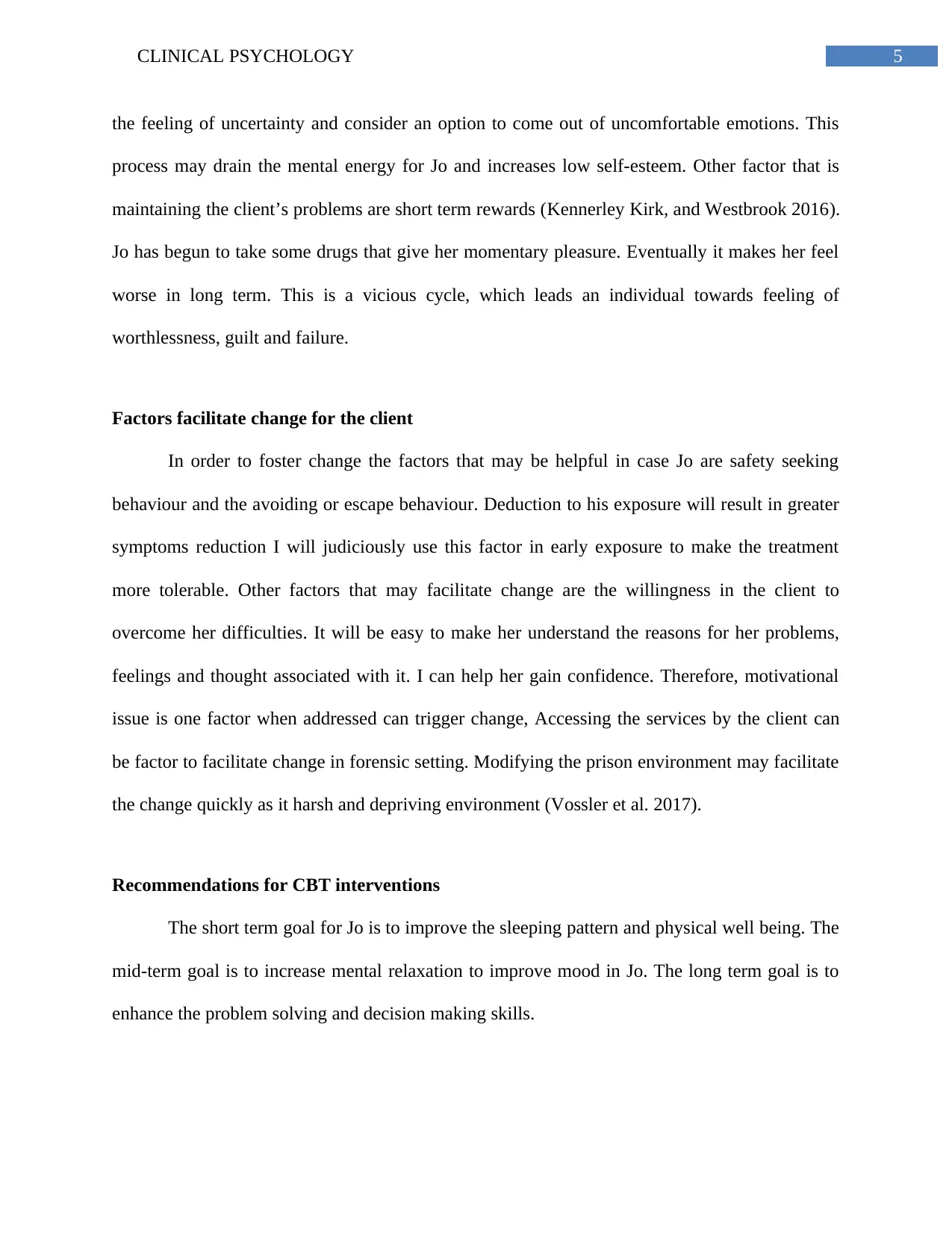
5CLINICAL PSYCHOLOGY
the feeling of uncertainty and consider an option to come out of uncomfortable emotions. This
process may drain the mental energy for Jo and increases low self-esteem. Other factor that is
maintaining the client’s problems are short term rewards (Kennerley Kirk, and Westbrook 2016).
Jo has begun to take some drugs that give her momentary pleasure. Eventually it makes her feel
worse in long term. This is a vicious cycle, which leads an individual towards feeling of
worthlessness, guilt and failure.
Factors facilitate change for the client
In order to foster change the factors that may be helpful in case Jo are safety seeking
behaviour and the avoiding or escape behaviour. Deduction to his exposure will result in greater
symptoms reduction I will judiciously use this factor in early exposure to make the treatment
more tolerable. Other factors that may facilitate change are the willingness in the client to
overcome her difficulties. It will be easy to make her understand the reasons for her problems,
feelings and thought associated with it. I can help her gain confidence. Therefore, motivational
issue is one factor when addressed can trigger change, Accessing the services by the client can
be factor to facilitate change in forensic setting. Modifying the prison environment may facilitate
the change quickly as it harsh and depriving environment (Vossler et al. 2017).
Recommendations for CBT interventions
The short term goal for Jo is to improve the sleeping pattern and physical well being. The
mid-term goal is to increase mental relaxation to improve mood in Jo. The long term goal is to
enhance the problem solving and decision making skills.
the feeling of uncertainty and consider an option to come out of uncomfortable emotions. This
process may drain the mental energy for Jo and increases low self-esteem. Other factor that is
maintaining the client’s problems are short term rewards (Kennerley Kirk, and Westbrook 2016).
Jo has begun to take some drugs that give her momentary pleasure. Eventually it makes her feel
worse in long term. This is a vicious cycle, which leads an individual towards feeling of
worthlessness, guilt and failure.
Factors facilitate change for the client
In order to foster change the factors that may be helpful in case Jo are safety seeking
behaviour and the avoiding or escape behaviour. Deduction to his exposure will result in greater
symptoms reduction I will judiciously use this factor in early exposure to make the treatment
more tolerable. Other factors that may facilitate change are the willingness in the client to
overcome her difficulties. It will be easy to make her understand the reasons for her problems,
feelings and thought associated with it. I can help her gain confidence. Therefore, motivational
issue is one factor when addressed can trigger change, Accessing the services by the client can
be factor to facilitate change in forensic setting. Modifying the prison environment may facilitate
the change quickly as it harsh and depriving environment (Vossler et al. 2017).
Recommendations for CBT interventions
The short term goal for Jo is to improve the sleeping pattern and physical well being. The
mid-term goal is to increase mental relaxation to improve mood in Jo. The long term goal is to
enhance the problem solving and decision making skills.
⊘ This is a preview!⊘
Do you want full access?
Subscribe today to unlock all pages.

Trusted by 1+ million students worldwide
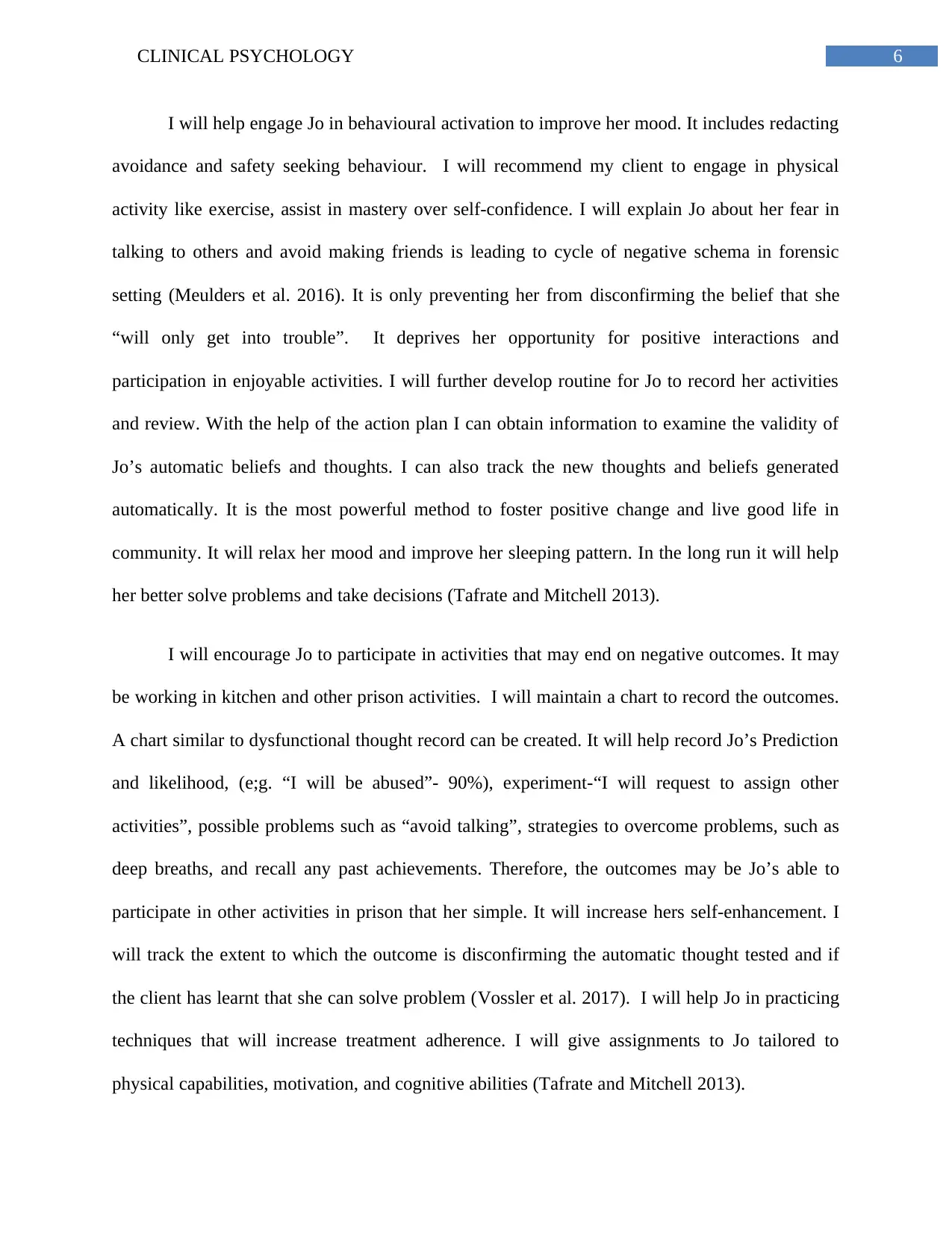
6CLINICAL PSYCHOLOGY
I will help engage Jo in behavioural activation to improve her mood. It includes redacting
avoidance and safety seeking behaviour. I will recommend my client to engage in physical
activity like exercise, assist in mastery over self-confidence. I will explain Jo about her fear in
talking to others and avoid making friends is leading to cycle of negative schema in forensic
setting (Meulders et al. 2016). It is only preventing her from disconfirming the belief that she
“will only get into trouble”. It deprives her opportunity for positive interactions and
participation in enjoyable activities. I will further develop routine for Jo to record her activities
and review. With the help of the action plan I can obtain information to examine the validity of
Jo’s automatic beliefs and thoughts. I can also track the new thoughts and beliefs generated
automatically. It is the most powerful method to foster positive change and live good life in
community. It will relax her mood and improve her sleeping pattern. In the long run it will help
her better solve problems and take decisions (Tafrate and Mitchell 2013).
I will encourage Jo to participate in activities that may end on negative outcomes. It may
be working in kitchen and other prison activities. I will maintain a chart to record the outcomes.
A chart similar to dysfunctional thought record can be created. It will help record Jo’s Prediction
and likelihood, (e;g. “I will be abused”- 90%), experiment-“I will request to assign other
activities”, possible problems such as “avoid talking”, strategies to overcome problems, such as
deep breaths, and recall any past achievements. Therefore, the outcomes may be Jo’s able to
participate in other activities in prison that her simple. It will increase hers self-enhancement. I
will track the extent to which the outcome is disconfirming the automatic thought tested and if
the client has learnt that she can solve problem (Vossler et al. 2017). I will help Jo in practicing
techniques that will increase treatment adherence. I will give assignments to Jo tailored to
physical capabilities, motivation, and cognitive abilities (Tafrate and Mitchell 2013).
I will help engage Jo in behavioural activation to improve her mood. It includes redacting
avoidance and safety seeking behaviour. I will recommend my client to engage in physical
activity like exercise, assist in mastery over self-confidence. I will explain Jo about her fear in
talking to others and avoid making friends is leading to cycle of negative schema in forensic
setting (Meulders et al. 2016). It is only preventing her from disconfirming the belief that she
“will only get into trouble”. It deprives her opportunity for positive interactions and
participation in enjoyable activities. I will further develop routine for Jo to record her activities
and review. With the help of the action plan I can obtain information to examine the validity of
Jo’s automatic beliefs and thoughts. I can also track the new thoughts and beliefs generated
automatically. It is the most powerful method to foster positive change and live good life in
community. It will relax her mood and improve her sleeping pattern. In the long run it will help
her better solve problems and take decisions (Tafrate and Mitchell 2013).
I will encourage Jo to participate in activities that may end on negative outcomes. It may
be working in kitchen and other prison activities. I will maintain a chart to record the outcomes.
A chart similar to dysfunctional thought record can be created. It will help record Jo’s Prediction
and likelihood, (e;g. “I will be abused”- 90%), experiment-“I will request to assign other
activities”, possible problems such as “avoid talking”, strategies to overcome problems, such as
deep breaths, and recall any past achievements. Therefore, the outcomes may be Jo’s able to
participate in other activities in prison that her simple. It will increase hers self-enhancement. I
will track the extent to which the outcome is disconfirming the automatic thought tested and if
the client has learnt that she can solve problem (Vossler et al. 2017). I will help Jo in practicing
techniques that will increase treatment adherence. I will give assignments to Jo tailored to
physical capabilities, motivation, and cognitive abilities (Tafrate and Mitchell 2013).
Paraphrase This Document
Need a fresh take? Get an instant paraphrase of this document with our AI Paraphraser
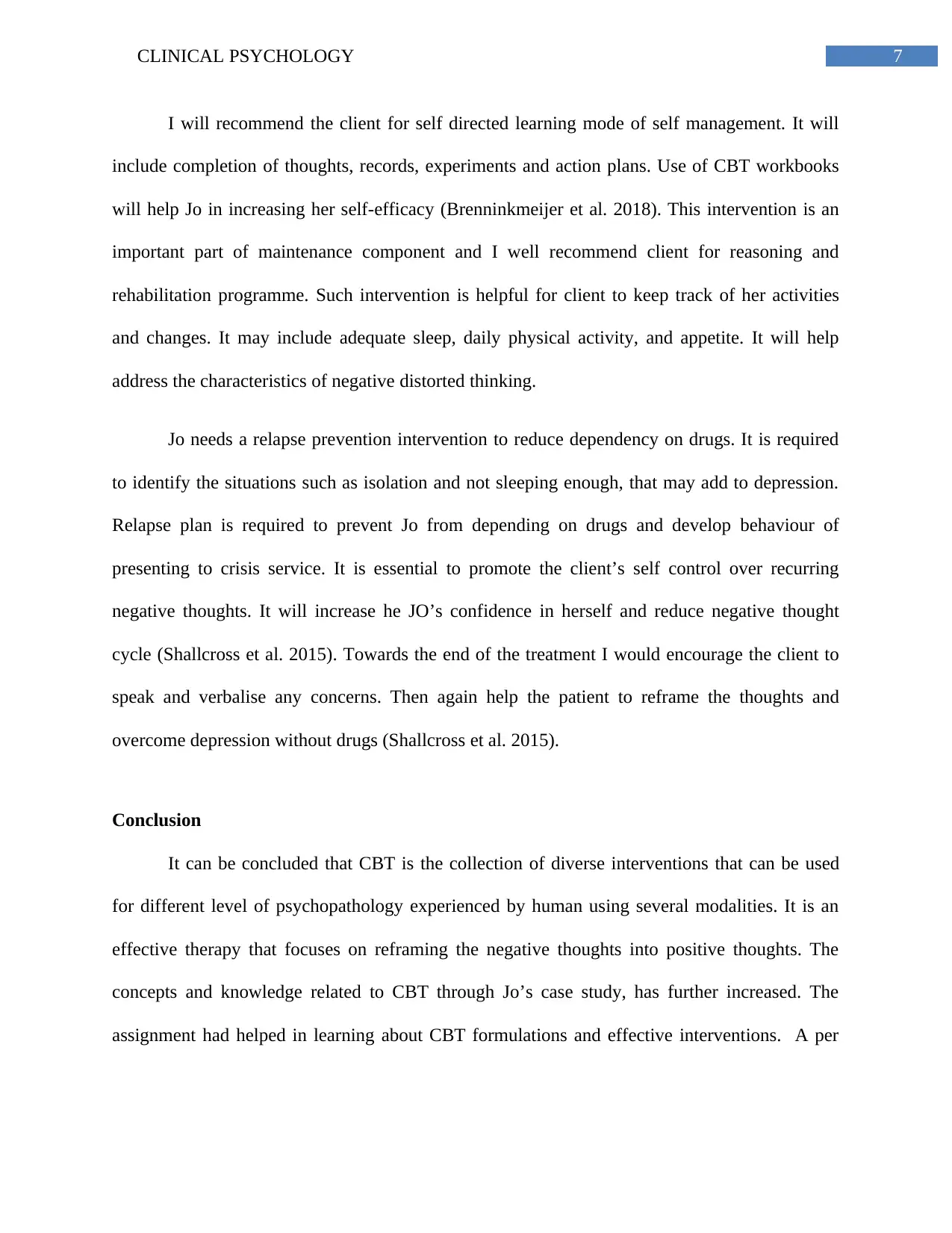
7CLINICAL PSYCHOLOGY
I will recommend the client for self directed learning mode of self management. It will
include completion of thoughts, records, experiments and action plans. Use of CBT workbooks
will help Jo in increasing her self-efficacy (Brenninkmeijer et al. 2018). This intervention is an
important part of maintenance component and I well recommend client for reasoning and
rehabilitation programme. Such intervention is helpful for client to keep track of her activities
and changes. It may include adequate sleep, daily physical activity, and appetite. It will help
address the characteristics of negative distorted thinking.
Jo needs a relapse prevention intervention to reduce dependency on drugs. It is required
to identify the situations such as isolation and not sleeping enough, that may add to depression.
Relapse plan is required to prevent Jo from depending on drugs and develop behaviour of
presenting to crisis service. It is essential to promote the client’s self control over recurring
negative thoughts. It will increase he JO’s confidence in herself and reduce negative thought
cycle (Shallcross et al. 2015). Towards the end of the treatment I would encourage the client to
speak and verbalise any concerns. Then again help the patient to reframe the thoughts and
overcome depression without drugs (Shallcross et al. 2015).
Conclusion
It can be concluded that CBT is the collection of diverse interventions that can be used
for different level of psychopathology experienced by human using several modalities. It is an
effective therapy that focuses on reframing the negative thoughts into positive thoughts. The
concepts and knowledge related to CBT through Jo’s case study, has further increased. The
assignment had helped in learning about CBT formulations and effective interventions. A per
I will recommend the client for self directed learning mode of self management. It will
include completion of thoughts, records, experiments and action plans. Use of CBT workbooks
will help Jo in increasing her self-efficacy (Brenninkmeijer et al. 2018). This intervention is an
important part of maintenance component and I well recommend client for reasoning and
rehabilitation programme. Such intervention is helpful for client to keep track of her activities
and changes. It may include adequate sleep, daily physical activity, and appetite. It will help
address the characteristics of negative distorted thinking.
Jo needs a relapse prevention intervention to reduce dependency on drugs. It is required
to identify the situations such as isolation and not sleeping enough, that may add to depression.
Relapse plan is required to prevent Jo from depending on drugs and develop behaviour of
presenting to crisis service. It is essential to promote the client’s self control over recurring
negative thoughts. It will increase he JO’s confidence in herself and reduce negative thought
cycle (Shallcross et al. 2015). Towards the end of the treatment I would encourage the client to
speak and verbalise any concerns. Then again help the patient to reframe the thoughts and
overcome depression without drugs (Shallcross et al. 2015).
Conclusion
It can be concluded that CBT is the collection of diverse interventions that can be used
for different level of psychopathology experienced by human using several modalities. It is an
effective therapy that focuses on reframing the negative thoughts into positive thoughts. The
concepts and knowledge related to CBT through Jo’s case study, has further increased. The
assignment had helped in learning about CBT formulations and effective interventions. A per
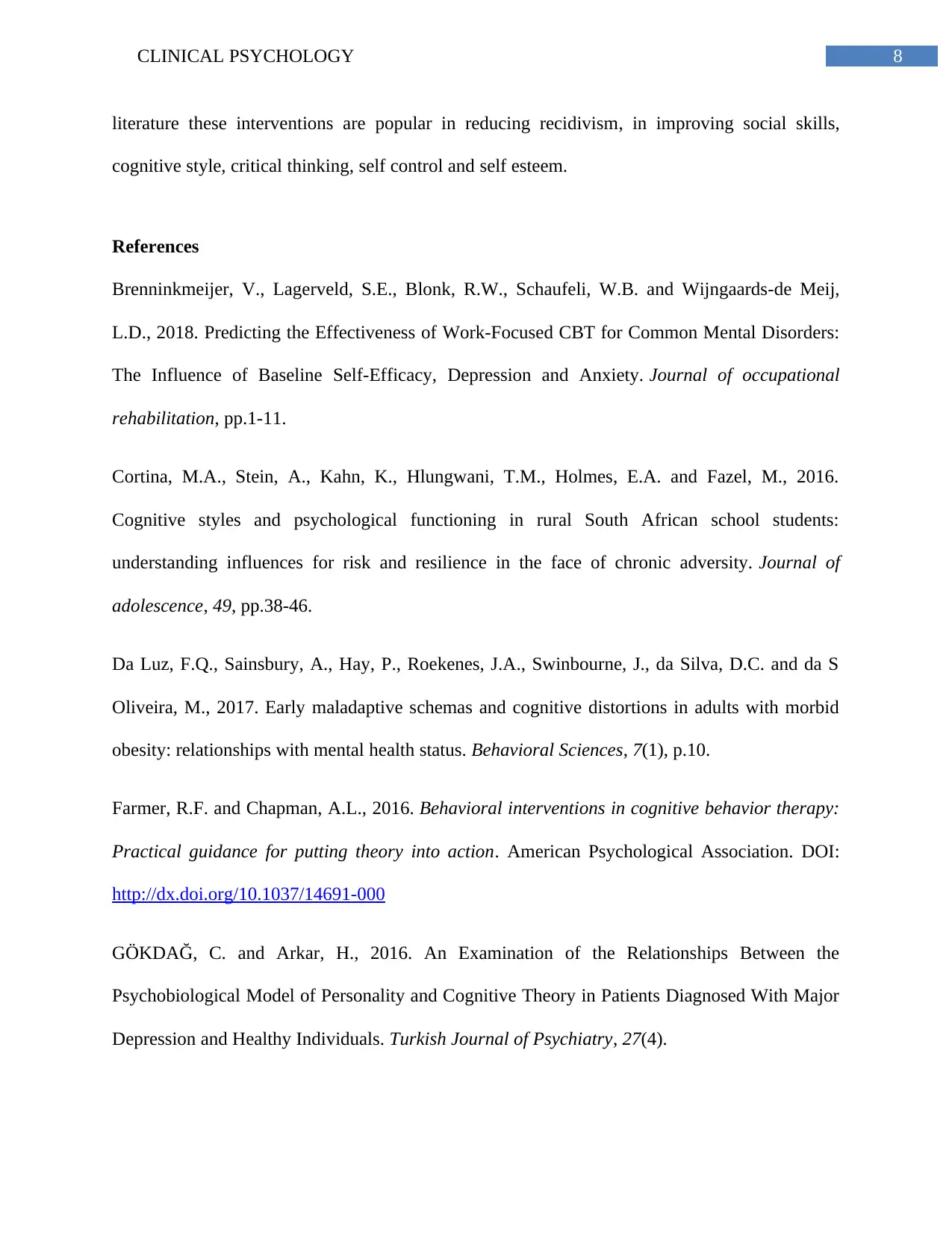
8CLINICAL PSYCHOLOGY
literature these interventions are popular in reducing recidivism, in improving social skills,
cognitive style, critical thinking, self control and self esteem.
References
Brenninkmeijer, V., Lagerveld, S.E., Blonk, R.W., Schaufeli, W.B. and Wijngaards-de Meij,
L.D., 2018. Predicting the Effectiveness of Work-Focused CBT for Common Mental Disorders:
The Influence of Baseline Self-Efficacy, Depression and Anxiety. Journal of occupational
rehabilitation, pp.1-11.
Cortina, M.A., Stein, A., Kahn, K., Hlungwani, T.M., Holmes, E.A. and Fazel, M., 2016.
Cognitive styles and psychological functioning in rural South African school students:
understanding influences for risk and resilience in the face of chronic adversity. Journal of
adolescence, 49, pp.38-46.
Da Luz, F.Q., Sainsbury, A., Hay, P., Roekenes, J.A., Swinbourne, J., da Silva, D.C. and da S
Oliveira, M., 2017. Early maladaptive schemas and cognitive distortions in adults with morbid
obesity: relationships with mental health status. Behavioral Sciences, 7(1), p.10.
Farmer, R.F. and Chapman, A.L., 2016. Behavioral interventions in cognitive behavior therapy:
Practical guidance for putting theory into action. American Psychological Association. DOI:
http://dx.doi.org/10.1037/14691-000
GÖKDAĞ, C. and Arkar, H., 2016. An Examination of the Relationships Between the
Psychobiological Model of Personality and Cognitive Theory in Patients Diagnosed With Major
Depression and Healthy Individuals. Turkish Journal of Psychiatry, 27(4).
literature these interventions are popular in reducing recidivism, in improving social skills,
cognitive style, critical thinking, self control and self esteem.
References
Brenninkmeijer, V., Lagerveld, S.E., Blonk, R.W., Schaufeli, W.B. and Wijngaards-de Meij,
L.D., 2018. Predicting the Effectiveness of Work-Focused CBT for Common Mental Disorders:
The Influence of Baseline Self-Efficacy, Depression and Anxiety. Journal of occupational
rehabilitation, pp.1-11.
Cortina, M.A., Stein, A., Kahn, K., Hlungwani, T.M., Holmes, E.A. and Fazel, M., 2016.
Cognitive styles and psychological functioning in rural South African school students:
understanding influences for risk and resilience in the face of chronic adversity. Journal of
adolescence, 49, pp.38-46.
Da Luz, F.Q., Sainsbury, A., Hay, P., Roekenes, J.A., Swinbourne, J., da Silva, D.C. and da S
Oliveira, M., 2017. Early maladaptive schemas and cognitive distortions in adults with morbid
obesity: relationships with mental health status. Behavioral Sciences, 7(1), p.10.
Farmer, R.F. and Chapman, A.L., 2016. Behavioral interventions in cognitive behavior therapy:
Practical guidance for putting theory into action. American Psychological Association. DOI:
http://dx.doi.org/10.1037/14691-000
GÖKDAĞ, C. and Arkar, H., 2016. An Examination of the Relationships Between the
Psychobiological Model of Personality and Cognitive Theory in Patients Diagnosed With Major
Depression and Healthy Individuals. Turkish Journal of Psychiatry, 27(4).
⊘ This is a preview!⊘
Do you want full access?
Subscribe today to unlock all pages.

Trusted by 1+ million students worldwide

9CLINICAL PSYCHOLOGY
Hyett, M.P. and McEvoy, P.M., 2018. Social anxiety disorder: looking back and moving
forward. Psychological medicine, pp.1-8.
Kennerley, H., Kirk, J. and Westbrook, D., 2016. An introduction to cognitive behaviour
therapy: Skills and applications. Sage. Retrieved from: https://books.google.co.in/books?
id=N_dnDQAAQBAJ&pg=PT142&lpg=PT142&dq=maintenance+cycles
%E2%80%99+that+keep+the+problematic+thoughts,+behaviours,
+affective+and+physiological+responses+going&source=bl&ots=Org5cwuK7u&sig=4LK83X-
TfIPAPLBlTw75nDy_5nM&hl=en&sa=X&ved=0ahUKEwjQ3tr-wfjZAhUMv48KHVIxA-
MQ6AEIKzAA#v=onepage&q=maintenance%20cycles%E2%80%99%20that%20keep%20the
%20problematic%20thoughts%2C%20behaviours%2C%20affective%20and%20physiological
%20responses%20going&f=false
Meulders, A., Van Daele, T., Volders, S. and Vlaeyen, J.W., 2016. The use of safety-seeking
behavior in exposure-based treatments for fear and anxiety: Benefit or burden? A meta-analytic
review. Clinical psychology review, 45, pp.144-156.
Rnic, K., Dozois, D.J. and Martin, R.A., 2016. Cognitive distortions, humor styles, and
depression. Europe's journal of psychology, 12(3), p.348.
Shallcross, A.J., Gross, J.J., Visvanathan, P.D., Kumar, N., Palfrey, A., Ford, B.Q., Dimidjian,
S., Shirk, S., Holm-Denoma, J., Goode, K.M. and Cox, E., 2015. Relapse prevention in major
depressive disorder: Mindfulness-based cognitive therapy versus an active control
condition. Journal of consulting and clinical psychology, 83(5), p.964.
Hyett, M.P. and McEvoy, P.M., 2018. Social anxiety disorder: looking back and moving
forward. Psychological medicine, pp.1-8.
Kennerley, H., Kirk, J. and Westbrook, D., 2016. An introduction to cognitive behaviour
therapy: Skills and applications. Sage. Retrieved from: https://books.google.co.in/books?
id=N_dnDQAAQBAJ&pg=PT142&lpg=PT142&dq=maintenance+cycles
%E2%80%99+that+keep+the+problematic+thoughts,+behaviours,
+affective+and+physiological+responses+going&source=bl&ots=Org5cwuK7u&sig=4LK83X-
TfIPAPLBlTw75nDy_5nM&hl=en&sa=X&ved=0ahUKEwjQ3tr-wfjZAhUMv48KHVIxA-
MQ6AEIKzAA#v=onepage&q=maintenance%20cycles%E2%80%99%20that%20keep%20the
%20problematic%20thoughts%2C%20behaviours%2C%20affective%20and%20physiological
%20responses%20going&f=false
Meulders, A., Van Daele, T., Volders, S. and Vlaeyen, J.W., 2016. The use of safety-seeking
behavior in exposure-based treatments for fear and anxiety: Benefit or burden? A meta-analytic
review. Clinical psychology review, 45, pp.144-156.
Rnic, K., Dozois, D.J. and Martin, R.A., 2016. Cognitive distortions, humor styles, and
depression. Europe's journal of psychology, 12(3), p.348.
Shallcross, A.J., Gross, J.J., Visvanathan, P.D., Kumar, N., Palfrey, A., Ford, B.Q., Dimidjian,
S., Shirk, S., Holm-Denoma, J., Goode, K.M. and Cox, E., 2015. Relapse prevention in major
depressive disorder: Mindfulness-based cognitive therapy versus an active control
condition. Journal of consulting and clinical psychology, 83(5), p.964.
Paraphrase This Document
Need a fresh take? Get an instant paraphrase of this document with our AI Paraphraser
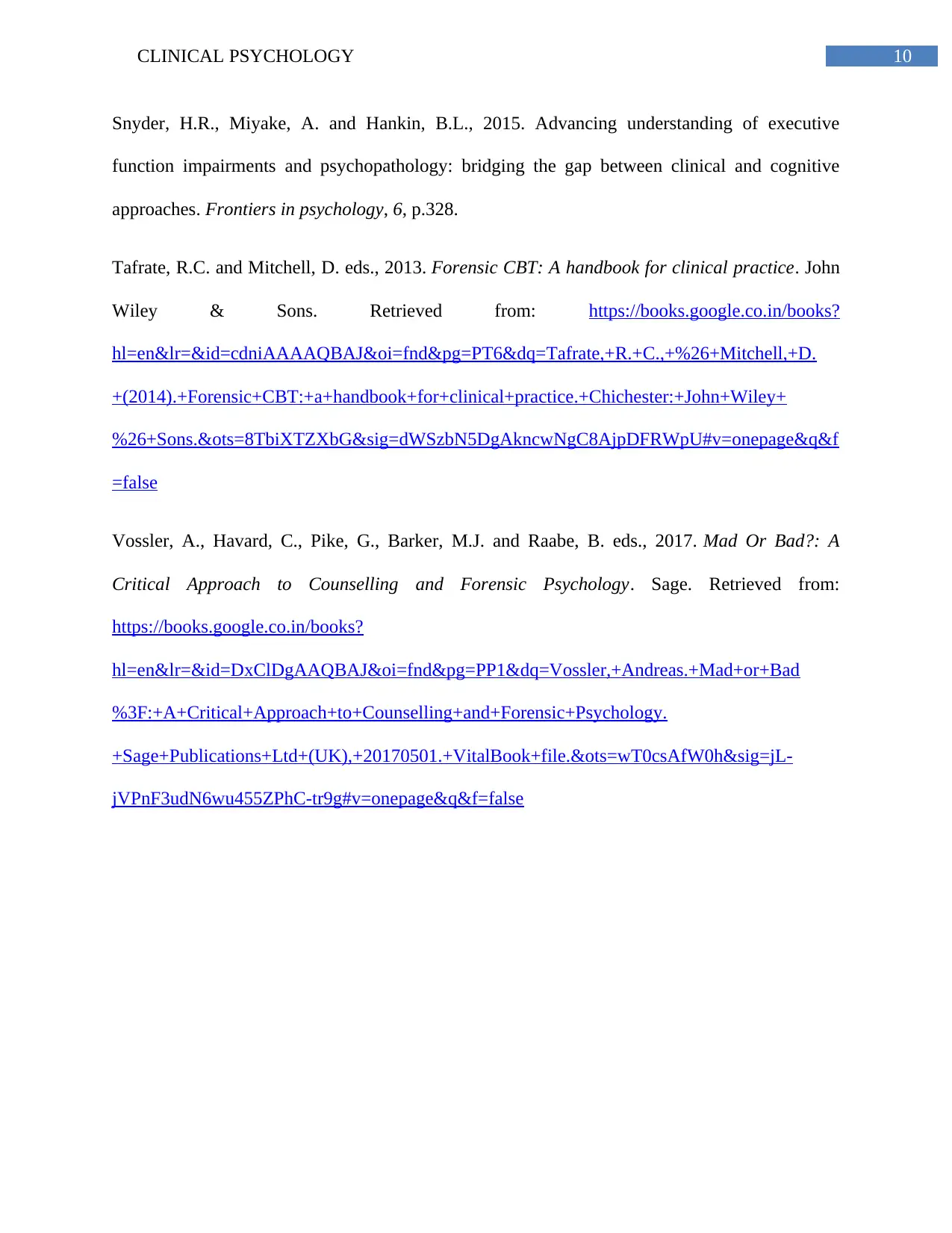
10CLINICAL PSYCHOLOGY
Snyder, H.R., Miyake, A. and Hankin, B.L., 2015. Advancing understanding of executive
function impairments and psychopathology: bridging the gap between clinical and cognitive
approaches. Frontiers in psychology, 6, p.328.
Tafrate, R.C. and Mitchell, D. eds., 2013. Forensic CBT: A handbook for clinical practice. John
Wiley & Sons. Retrieved from: https://books.google.co.in/books?
hl=en&lr=&id=cdniAAAAQBAJ&oi=fnd&pg=PT6&dq=Tafrate,+R.+C.,+%26+Mitchell,+D.
+(2014).+Forensic+CBT:+a+handbook+for+clinical+practice.+Chichester:+John+Wiley+
%26+Sons.&ots=8TbiXTZXbG&sig=dWSzbN5DgAkncwNgC8AjpDFRWpU#v=onepage&q&f
=false
Vossler, A., Havard, C., Pike, G., Barker, M.J. and Raabe, B. eds., 2017. Mad Or Bad?: A
Critical Approach to Counselling and Forensic Psychology. Sage. Retrieved from:
https://books.google.co.in/books?
hl=en&lr=&id=DxClDgAAQBAJ&oi=fnd&pg=PP1&dq=Vossler,+Andreas.+Mad+or+Bad
%3F:+A+Critical+Approach+to+Counselling+and+Forensic+Psychology.
+Sage+Publications+Ltd+(UK),+20170501.+VitalBook+file.&ots=wT0csAfW0h&sig=jL-
jVPnF3udN6wu455ZPhC-tr9g#v=onepage&q&f=false
Snyder, H.R., Miyake, A. and Hankin, B.L., 2015. Advancing understanding of executive
function impairments and psychopathology: bridging the gap between clinical and cognitive
approaches. Frontiers in psychology, 6, p.328.
Tafrate, R.C. and Mitchell, D. eds., 2013. Forensic CBT: A handbook for clinical practice. John
Wiley & Sons. Retrieved from: https://books.google.co.in/books?
hl=en&lr=&id=cdniAAAAQBAJ&oi=fnd&pg=PT6&dq=Tafrate,+R.+C.,+%26+Mitchell,+D.
+(2014).+Forensic+CBT:+a+handbook+for+clinical+practice.+Chichester:+John+Wiley+
%26+Sons.&ots=8TbiXTZXbG&sig=dWSzbN5DgAkncwNgC8AjpDFRWpU#v=onepage&q&f
=false
Vossler, A., Havard, C., Pike, G., Barker, M.J. and Raabe, B. eds., 2017. Mad Or Bad?: A
Critical Approach to Counselling and Forensic Psychology. Sage. Retrieved from:
https://books.google.co.in/books?
hl=en&lr=&id=DxClDgAAQBAJ&oi=fnd&pg=PP1&dq=Vossler,+Andreas.+Mad+or+Bad
%3F:+A+Critical+Approach+to+Counselling+and+Forensic+Psychology.
+Sage+Publications+Ltd+(UK),+20170501.+VitalBook+file.&ots=wT0csAfW0h&sig=jL-
jVPnF3udN6wu455ZPhC-tr9g#v=onepage&q&f=false
1 out of 11
Related Documents
Your All-in-One AI-Powered Toolkit for Academic Success.
+13062052269
info@desklib.com
Available 24*7 on WhatsApp / Email
![[object Object]](/_next/static/media/star-bottom.7253800d.svg)
Unlock your academic potential
Copyright © 2020–2026 A2Z Services. All Rights Reserved. Developed and managed by ZUCOL.





